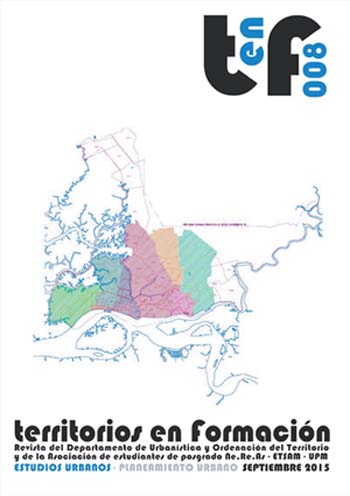Beirut 1830-1920, un ‘scalar fix’ en contextos cambiantes. Un estudio de caso explorando las teorías de re-escalamiento y urbanización extendida
DOI:
https://doi.org/10.20868/tf.2015.8.3096Palabras clave:
escala, re-escalamiento, urbanización, concentración, extensión, economía-mundoResumen
Los estudios urbanos están experimentado un discurso renovado sobre la producción del espacio urbano. Se aborda de nuevo la “cuestión urbana”, visto que el discurso existente es incapaz de explicar la producción de los actuales paisajes socioespaciales. La teoría de la “urbanización planetaria” o de la “urbanización extendida” propone un paradigma pionero para el estudio de lo urbano. Centrándose en los procesos en vez de los asentamientos urbanos, dicha teoría postula que el fenómeno de urbanización es el resultado de dos momentos: concentración y extensión. A su vez, dicha teoría aboga por la necesidad de contemplar dichos procesos desde una perspectiva histórico-geográfica. Aplicando este enfoque a la ciudad de Beirut, este articulo pone a prueba las hipótesis de estos nuevos empeños teóricos. Al mismo tiempo, el análisis conecta con conceptualizaciones previas relacionadas con el territorio: las teorías del re-escalamiento y del sistema mundo. En efecto, la extensión y concentración cuestionan la implicación de la escala en la producción de estos dos momentos de urbanización. También el proceso de urbanización, entendido como un proceso histórico continuo, aborda inevitablemente aspectos de la teoría del sistema mundo, que son relevantes para enmarcar la teoría de urbanización en el periodo específico, 1830-1920, del caso de estudio.
Descargas
Referencias
ABOU HODEIB, T. (2011). “Taste and class in late ottoman Beirut”, International Journal of Middle East Studies, 43, pp. 475-492.
BRENNER, N. (1998). “Between fixity and motion: accumulation, territorial organization and the historical geography of special scales”, Environment and Planning: Society and Space, 16 (4), pp. 459-481.
BRENNER, N. (2001). “The limits to scale? Methodological reflections on scalar structuration”, Progress in Human Geography, 25 (4), pp. 591-614.
BRENNER, N. (2013). “Thesis on urbanization”, Public Culture, 25 (1), pp. 85-114.
BRENNER, N. & SCHMID, C. (2012). “Planetary urbanization”, in: GANDY, M. (ed.), Urban constellations, Berlin: Jovis, pp. 10-13.
BRENNER, N. (2013). “The ‘urban age’ in question”, International Journal of Urban and Regional Researc, 38 (3), pp. 731-755.
CHASE-DUNN, C. (2007). “Dependency and world-systems theories”, in: RITZER, G. (ed.), Blackwell encyclopedia of sociology online, pp. 1,060-1,061.
COX, K. R., (1996). “The difference that scale makes”, Political Geograpghy, 15 (8), pp. 667-669.
DAVIE, M. (1996). Beyrouth et ses faubourgs, Beirut: IFPO.
DAVIE, M. F. (1987). “Maps and the historical topography of Beirut”, Berytus, 35, pp. 141-164.
DERINGIL, S. (1998). The Well-Protected Domains: Ideology and the Legitimation of Power in the Ottoman Empire 1876-1909. London: I. B. Tauris, pp. 9-10.
FAWAZ, L. (1983). Merchants & migrants in nineteenth-century Beirut, London: Harvard University Press.
FAWAZ, L(1984). “The city and the mountain: Beirut’s political radius in the nineteenth century as revealed in the crisis of 1860”, International Journal of Middle East Studies, 16 (4), pp. 489-495.
FISCHFICH, A. (2011) Formes urbaines et architecturales de Beyrouth (depuis le XIXe siècle jusqu’à nos jours), Beirut: Alba, Université de Balamand.
HANNA, N. (2005). “Survey of urban history of arab cities in the ottoman period”, Talíd, 3 (6), pp. 89-102.
HANSSEN, J. (1998). “‘Your Beirut is on my desk’, ottomanizing Beirut under sultan Abdulhamid II (1876-1909)”, in: SARKIS, H. & ROWE, C. (eds.), Projecting Beirut, New York: Prestel.
HANSSEN, J (2005). Fin de siècle Beirut: The making of an ottoman provincial capital, Oxford/New York: Oxford University Press.
HOURANI, A. (1981). The emergence of the modern Middle East, Berkeley/Los Angeles: University of California Press, pp. 36-66 & 170-178.
ISSAWI, C. (1977). “British trade and the rise of Beyrouth 1830-1860”, International Journal of Middle East Studies, 8 (1), pp. 91-101.
JESSOP, B.; BRENNER, N. & JONES, M. (2008). “Theorizing sociospatial relations”, Environment and Planning: Society and Space, 26 (3), pp. 389-401.
KASSIR, S. (2005). Histoire de Beyrouth, Paris: Fayard.
KERN, S. (2003). The culture of time and space: 1880-1918, Cambridge: Harvard University Press.
KEYDER, Ç.; QUATAERT, D. & ÖZEVERN, Y. E. (1993). “Port-cities in the Ottoman Empire: Some theoretical and historical perspectives”, Review (Fernand Braudel Center), 16 (4), pp. 519-558.
LAFI, N. (2005). Municipalités méditerranéennes: Les réformes urbaines ottomanes au miroir d’une histoire compareée (Moyen-Orient, Maghreb, Europe Méridionale), Berlin: Klaus Schwarz Verlag.
LAFI, N. & FREITAG, U. (2011). “Daily life and family in an Ottoman urban context: historiographical”, History of the Family, 16, pp. 80-87.
MAKDISI, U. (2000). “Corrupting the sublime sutlanate: The revolt of Tanyus Shahin in nineteenth-century Ottoman Lebanon”, Cambridge University Press, 42 (1), pp. 180-208.
MARTSON, S.A. (2000). “The social construction of scale”, Progress in Human Geography, 24 (2), pp. 219-242.
MUNDY, M. & SAUMAREZ S. R. (2007). Governing property, making the modern state: law administration and production in ottoman Syria, United Kingdom: I. B. Tauris & co. ltd, pp. 40-52.
OWEN, R. (1993) The Middle East in the world economy 1800-1914, United Kingdom: I. B. Tauris & co. ltd.
ÖZEVERN, Y. E. (1993). “Beirut”, Review (Fernand Braudel Center), 16 (4), pp. 467-497.
ÖZTÜRK, P. K. (2006). Urban transformation of Ottoman port-cities in the nineteenth century: The change from Ottoman Beirut to French mandatory Beirut. Thesis, Graduate School of Social Sciences, Middle East Technical University, Turkey.
QUATAERT, D. (2009). “Review: Karen Barkey. Empire of difference: The ottomans in comparative perspective. New York: Cambridge University Press. 2008”, American Historical Review, 114 (2), pp. 413-415.
SMITH, N. (1992). “Contours of a spatialized politics: Homeless vehicles and the production of geographical scale”, Social Text, 33, pp. 54-81.
SWYNGEDOUW, E. (2004). “Globalisation or ‘glocalisation’? Networks, territories and rescaling”, Cambridge Review of International Affairs, 17 (1), pp. 25-48.
TAYLOR, P. J. (1994). Geografia política: Economía-mundo, estado-nación y localidad, Madrid: Trama editorial.
WALLERSTEIN, I. (1983). Historical capitalism, London/New York: Verso.
(1996). “The inventions of time space realities: towards an understanding of our historical system”, Journal of the Geographical Association, 73 (4), pp. 289-297.









